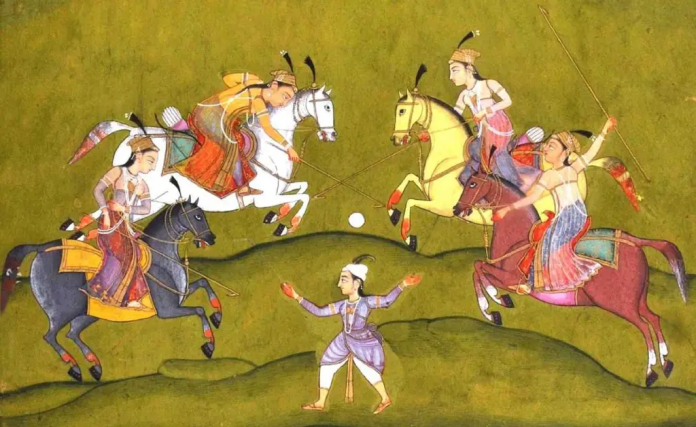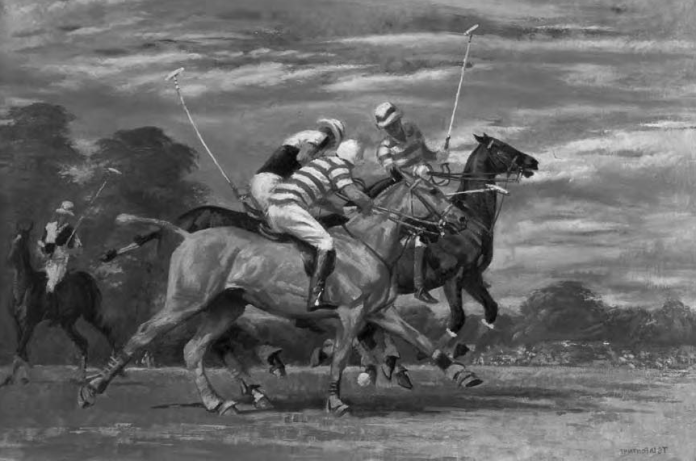“Polo has continued its ceaseless gallop into the future. From the dim, impenetrable recesses of time, the mounted figure of this sport came cantering into the pages of our first histories and has gone swinging along ever since, side by side with the march of man, oblivious to changing fashions and changing nations, remaining always the calm patrician of sport.” – Robert F. Kelley
Polo, as we know it today, was born in the rugged landscape of Asia and existed in a way that was very different from what we imagine it to be today. The Polo game was not a ‘sport’ but rather a fun indulgence. It was played by men, women, and children, mounted on true ponies and thoroughbred racehorses, on dusty paddocks and green fields, and bare grounds. Rather than sticking to the historical roots of the game, this article understands how the Polo game was before it became polo sport- the way the folk tradition existed and what subsequently led to the establishment of the polo sport. We understand that polo is a dynamic sport that has emerged in its modern condition through the interplay of various elements that keep it going in today’s times and days.
A Folk Game
Ancient folk games, forerunners of many modern sports, were distinguished by several unique characteristics, whether the mode was equine or pedestrian. The number of participants, the size and form of the field, the type of amusement, and other factors all varied greatly. In most communities, playing folk games was a deeply rooted tradition. The present game of polo bears very little relation to these early variations. Hundreds of people took part in the Buzkashi version, where the horseman with the courage to grab a decapitated goat by the leg and drag the carcass away from the herd was declared the winner. The spherical ball, known as the GUI, was the size of a man’s head in another variation that was comparable to the present game.
The teams may consist of up to 1,000 horsemen apiece. Stone pillars served as goals at each of the ground’s 6 PART I: THE TRIBESMEN ends. The game, which in Persian is called chowgIn, is played by hitting a ball with a wooden stick until the ball is shattered. The oldest goalposts still in use date to the 17th century and are found in Isfahan, Iran’s center square (Naghsh-é-Jahan), are 24 feet wide, which is exactly the distance specified in the game’s current rules. They are seven feet tall, built of stone, and have a bishop’s miter-like decoration on top. The Juche or Nüchên (early Manchus) emperors who succeeded the Cathayans and who are mentioned by Marco Polo under the name Chorené are frequently described in Chinese history as players of polo. The game’s regulations stipulated that the ball should only be struck while galloping; beware of modern proponents who tap the ball while walking; that the game was governed by an unwritten code of conduct rather than a written rulebook. Compared to all rules in Western nations, etiquette has a considerably greater regulating influence in Eastern culture.
Royal Support
As with polo’s forerunners, the folk game gradually received royal support. The Parthian dynasty, which ruled from 247 to 550, is believed to have been the game’s first patron, according to the game’s oldest written mentions in a text from the seventh century. The imperial support for polo in Persia persisted under the Turkic and Mongol emperors in the eleventh century. Sir Anthony Shirley, an English traveler, noted that the Safavid monarchy had elite polo players. After the Mongols, Persia was ruled by the Safanids. Later, the game lost popularity until two additional Englishmen, Sir Horace Rumbold and Maj. Percy Molesworth Sykes, later Brig. Gen. Sir Percy Sykes introduced the current version of the game to Persia in the final years of the 19th century. Emperor Manuel I Comnenos reigned from 1143 to 1180 and was a passionate polo fan. In a document, Johannes Cinnamus, authored in 1190 describes a game played with an apple-sized leather ball where two teams competed. The sticks were finished with a hoop and a string net that looked like a racket. Interestingly, despite the great distance involved, comparable equipment was also used in Japan, which is difficult to understand. The game was played with equipment not found in any other Asiatic location. The Royal patronage of Polo paved the way for Polo Sport as we know it today and this led to the fading away of the rural, folk polo game and polo matches became a site of royal sportsmanship. Polo sport developed through this patronage and transformed drastically in its rules and methods.
A letter to the editor of The Pioneer in Allahabad, published on 4 September 1878, gives an idea of what the games were. Typically, but not always, each squad included eight players, sometimes with two goalkeepers. Goalkeepers were soon abolished as it became clear that they played a minimal part in games with an open play. The offside rule, which greatly favored the opposition back, prevented the team’s number one player, commonly known as the flying man, from being effective at the other end. However, only five players remained, and they played four-on-four.
Polo Today
Polo sport today is much more than just a game. It has extended beyond the folk tradition; today, the word polo does not exist in itself. Polo sport is an established field and in every right way. However, its sweet lingering nostalgia as a folk game; one played in fields with fewer restrictions and more folk popularity; is a good way to look back at what today has become the polo sport. Polo sport’s glory was brought by its exceptional ability to attract royal patronage yet its humble folk beginnings and its folk traditions continue to influence polo matches even today.





